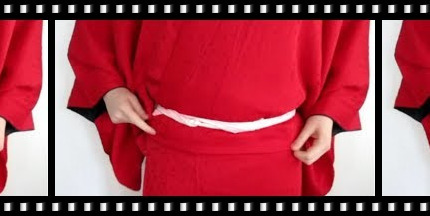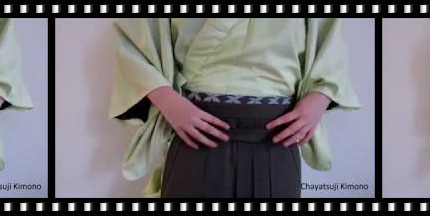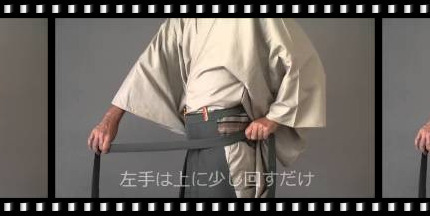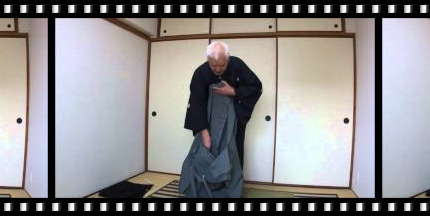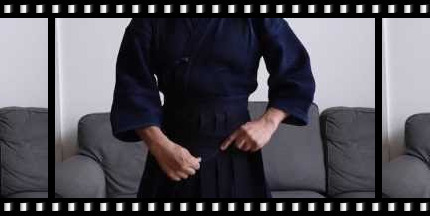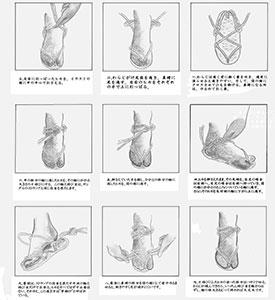Kimono step by step guide, page 2: "kimono to accesoires"
Kimono step by step guide,
page 2: "kimono to accesoires"
(click here for "socks to underwear" portion of the guide)

Kimono (or Nagaki)
The most important things to remember when putting on a kimono are:
You wrap the kimono left over right, the other way around is 'reserved' for the people who died.
Kimono follows the body | | and does not spread like a long skirt / \
Some quick pointers before the instruction video's:

1) Pull the end of the eri forward and make sure it is at equal hight.

2) Always wrap the kimono with the left side over the right.

3) Make sure the fold at the back is at the center of your body.

4) To prevent the kimono from opening again, use a koshi-himo.

5a) make sure the kimono follows the body

5b) and not worn wide like a skirt.
Kimono size chart
| Size | Your size | Dress Length | Sleeve length | Sleeve + Shoulder width | shoulder width | Sleeve width |
|---|---|---|---|---|---|---|
| S | 160cm~165cm | 140 | 49 | 68 | 34 | 34 |
| M | 166cm~170cm | 142 | 49 | 72 | 36 | 36 |
| L | 171cm~175cm | 146 | 51 | 74 | 37 | 37 |
| LL | 176cm~183cm | 151 | 53 | 76 | 37 | 37 |
| 3L | 184cm~190cm | 155 | 55 | 78 | 39 | 39 |
| Size | Your size | Dress Length | Sleeve length |
|---|---|---|---|
| S | 160cm~165cm | 140 | 49 |
| M | 166cm~170cm | 142 | 49 |
| L | 171cm~175cm | 146 | 51 |
| LL | 176cm~183cm | 151 | 53 |
| 3L | 184cm~190cm | 155 | 55 |
| Size | Your size | shoulder width | Sleeve width |
|---|---|---|---|
| S | 160cm~165cm | 34 | 34 |
| M | 166cm~170cm | 36 | 36 |
| L | 171cm~175cm | 37 | 37 |
| LL | 176cm~183cm | 37 | 37 |
| 3L | 184cm~190cm | 39 | 39 |
For one seller 3L is for 185cm sized people but with another seller the size would be LL or 4L.
 Main point to remember is to focus on the 'dress length' and 'shoulder width', when you have found out which of those values fit you the best, suddenly searching for a new kimono becomes much and much easier
Main point to remember is to focus on the 'dress length' and 'shoulder width', when you have found out which of those values fit you the best, suddenly searching for a new kimono becomes much and much easier


Koshi-himo too tight ?
Check out the 'For your convenience' page where among other things the kistuke-belt and elastic koshi-himo is detailed. Especially the elastic koshi-himo is a breather when using as the first cord !
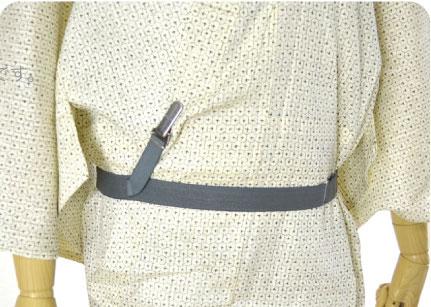 Kistuke belt
Kistuke belt
 Elastic koshi himo
Elastic koshi himo


Kimono too tall ?
If you haven't bought a tailor made Kimono then there is a chance the Kimono length be a bit too long. This isn't much of a problem, when putting on the Kimono and after tying (an extra) Koshi-himo (cord), you pull the Kimono up and let it fall back again over the cord. This part will be covered again by the Obi or if you want with an extra layer with the use of a Datejime.


Obi / Sash
Time to put on the obi / sash, for women a daunting task, for men a relative simple task and fast to put on.
I have created a seperate section ( "How to tie the knot" ) where you can find a collection of different knots for the various kinds of obi and how you can create them like:
Some examples of obi knots that men can use:



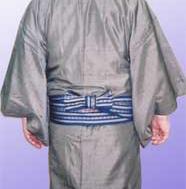
The different kinds of obi types that are available for men are:


The standard obi for men is the kaku obi, a stiff roughly 10-12cm wide and 400cm long obi suited for all occasions from festival to wedding. The most wide known is the obi with the striped patterns named hakata-obi (left) but many pattern variations exist such as the one displayed on the right image.
This obi is thicker then the one for the Yukata.


Very thin but stiff material. Usually has a more festive design, although obi without or with a simple pattern is also available. The choice when you are an adult and aren't suited anymore for a heko-obi. Size is 400cm by 9-11 cm.


Then we have the heko obi to be worn with a yukata. The heko obi is a wide and loose fabric sash for boys, girls or men till 25 years (adults can still wear them at home). An heko-obi is about 30-75cm wide and 350-400cm long.


This obi is around 5-8 cm wide and 214-255cm long, is worn with a yukata, especially with yukata at the onsen/ryokan by everyone be it kid or adult or women or men. It can also be worn as a date-jime obi on kimonos or used under the kaku obi belt.
Tie the sash in a bow and place the knot to off-center of the body.


Odori means dance and could be worn at a Nihon Buyou (Japanese traditional dance festival) or Bon-odori (Festival to honor the spirits of one's ancestors).
A men's odori obi is about 10cm wide and 350cm long.


Talk about surprises, a kaku-obi with strings attached to it (紐付き角帯).
Not sure, but it looks that 'Fujikiya-Kimono' has created an interesting and stylish (cotton) obi addition. Have not been able to find length and width yet.
Youtube video 'string attached kaku-obi'
 So which lines should be on top ?
So which lines should be on top ?Good question and have not found a real answer, most people on the forums will state "who cares as long as you have fun" but for me it's a thing I want to know.
Maybe there is no "rule" on which way should be up or down but knowing that is also an answer :)
When alle lines look about the same thinkness, the hanazura (see below link what an hanazura line is) on top ?
The meaning of these lines can be found on the various page.


Haori / Jacket
An Haori is a kimono shaped jacket designed to be worn on top of a kimono.
When going outside, except when when wearing a summer kimono, you can put on an haori. Putting one on increases the level of formality. Not much to show on how to put on this clothing piece, see the next part (haori-himo) of this posting how to 'button' this jacket.
Just one thing, fold the collar down in half at the back so that the haori neck part is lower than the kimono color. Only the back part of the color though, let is go back naturally to full width in front. (see most right image)
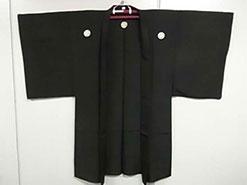

| size | Your height | Clothing height | Height of sleeve | Sleeve + shoulder width | Sleeve width |
|---|---|---|---|---|---|
| S | 160cm~165cm | 93cm | 50cm | 69cm | 34.5cm |
| M | 165cm~170cm | 96cm | 50cm | 73cm | 36.5cm |
| L | 170cm~175cm | 99cm | 52cm | 75cm | 37cm |
| LL | 175cm~180cm | 106cm | 54cm | 77cm | 38cm |
| 3L | 180cm~190cm | 109~112cm | 56cm | 79cm | 39cm |
| size | Your height | Clothing height | Height of sleeve |
|---|---|---|---|
| S | 160cm~165cm | 93cm | 50cm |
| M | 165cm~170cm | 96cm | 50cm |
| L | 170cm~175cm | 99cm | 52cm |
| LL | 175cm~180cm | 106cm | 54cm |
| 3L | 180cm~190cm | 109~112cm | 56cm |
| size | Sleeve + shoulder width | Sleeve width |
|---|---|---|
| S | 69cm | 34.5cm |
| M | 73cm | 36.5cm |
| L | 75cm | 37cm |
| LL | 77cm | 38cm |
| 3L | 79cm | 39cm |
 Rikyu haori (sleeveless haori made from silk)
Rikyu haori (sleeveless haori made from silk)利休羽織 - rikyu haori (tight fit against shoulders, literally no sleeve)
 sode-nashi haori (sleeveless haori made from cotton)
sode-nashi haori (sleeveless haori made from cotton)袖なしの羽織 - sode-nashi haori (broad width, so it looms a bit over the shoulder.
For casual outings or at home.
 Chabaori (Jacket for Tea Ceremony / Free time outer robe)
Chabaori (Jacket for Tea Ceremony / Free time outer robe)It seems the Chabaori has 2 different uses, one for the master of the Tea Ceremony and the other is as casual clothing at home and garden.
Chaboari differs from ordinary haori by its shorter length. On this photo you can see chabaori which is usually offered to guests in Japanese hotels to be worn over the yakata when going out. Usually chabaori are sewed from thick wool because chabaori is warm dress. Tapes are made from the same fabric.
 Jittoku
JittokuJuttoku (十徳) or Hirosode (広袖), sometimes called a jittoku haori, is a type of haori worn only by men. Jittoku are only made of unlined ro or sha silk gauze regardless of the season. They fall to the hip, and have sewn himo made of the same fabric as the main garment. While a haori has a small sleeve opening like that of a kimono, a jittoku is fully open at the wrist side. Jittoku do not have mon.
Jittoku originated in the Kamakura period (1185-1333 CE), and by the Edo period (1603-1868) they were worn with kimono by male doctors, monks, Confucian scholars and tea ceremony masters as kinagashi (as a replacement for hakama). In the modern day they are worn as kinagashi mainly by male practitioners of tea ceremony who have achieved a sufficiently high rank.
sode-nashi haori size chart
| size | your height | width of clothing | back width | height of clothing | waist size |
|---|---|---|---|---|---|
| M | 160cm~170 | 54cm | 25.5~29.5cm | 75.5~78cm | 71~80 |
| L | 170cm~175 | 54cm | 31~32cm | 81~82cm | 81~90 |
| LL | 175cm~185 | 54cm | ??cm | 86cm | 91~100 |
| size | your height | width of clothing | back width |
|---|---|---|---|
| M | 160cm~170 | 54cm | 25.5~29.5cm |
| L | 170cm~175 | 54cm | 31~32cm |
| LL | 175cm~185 | 54cm | ??cm |
| size | height of clothing | waist size |
|---|---|---|
| M | 75.5~78cm | 71~80 |
| L | 81~82cm | 81~90 |
| LL | 86cm | 91~100 |
rikyu haori size chart (indication, every store seems to have different sizes)
| size | dress length | width of clothing | height of clothing | waist size |
|---|---|---|---|---|
| S | 155cm~160cm | 52~55cm | 74~78cm | 61~70 |
| M | 160cm~168cm | 55~57cm | 80~83cm | 71~80 |
| L | 168cm~175cm | 59~62cm | 85~88cm | 81~90 |
| LL | 175cm~182cm | 62~65cm | 90~93cm | 91~100 |
| size | dress length | width of clothing |
|---|---|---|
| S | 155cm~160cm | 52~55cm |
| M | 160cm~168cm | 55~57cm |
| L | 168cm~175cm | 59~62cm |
| LL | 175cm~182cm | 62~65cm |
| size | height of clothing | waist size |
|---|---|---|
| S | 74~78cm | 61~70 |
| M | 80~83cm | 71~80 |
| L | 85~88cm | 81~90 |
| LL | 90~93cm | 91~100 |


Haori-himo
The haori is not wrapped around the body and hold firm by a sash but hangs loosely connected by a Haori-himo.
Wearing an haori without an himo is perfectly acceptable if the haori isn't formal. Also note that summer haori are usually worn without himo. Sodenashi (sleeveless) haori were traditionally worn without himo but it seems it's trendy to wear a himo with them now.
Please go to the haorihimo section in the 'How to tie the knot' sub page for the different kinds of haori-himo and how to attach them.













The original Japanese page where these images came from can be found at http://homepage2.nifty.com/910/yumi2/d03_02f.html [ Kimono Taizen ] (site not found anymore)


Hakama
For those official times (together or without an Haori) or when practicing martial sports (without haori).
An hakama is a pleated garment with 7 folds, a stiff backboard and long ties that have a complex way of being tied. The Hakama has significant meaning applied to its design.
The seven folds in the hakama represent seven virtues of the Samurai - Yuki (courage), Jin (humility), Gi (justice), Rei (chivalry), Makoto (honesty), Chugi (loyalty), and Meiyo (prestige).
When wearing a hakama the most common knot for the obi would be an ichimonji where after the kimono is tucked up into the obi at the back.
The hakama is then secured to the body using the four hakama himo.
The most formal knot is a jūnoji, which resembles the kanji for the number 10. The semi formal knot is the ichimonji, which resembles a bow tie, and the simple square knot for the casual feel.
 traditional formal hakama
traditional formal hakama(thin stripes)
 modern version of formal hakama
modern version of formal hakama(thicker stripes)
 plain uma nori hakama
plain uma nori hakama(casual)
 umanori hakama with crane and cart
umanori hakama with crane and cart(for dance)
 umanori hakama with woven lozenge patterns
umanori hakama with woven lozenge patterns(casual)
 traditional formal hakama
traditional formal hakama(thin stripes)
 modern version of formal hakama
modern version of formal hakama(thicker stripes)
 plain umanori hakama
plain umanori hakama(casual)
 umanori hakama with crane and cart
umanori hakama with crane and cart(for dance)
 umanori hakama with woven lozenge patterns
umanori hakama with woven lozenge patterns(casual)
hakama size chart
| size | your height | dress length |
|---|---|---|
| S | 159cm-165cm | 87cm |
| M | 166cm-172cm | 91cm |
| L | 173cm-179cm | 95cm |
| LL | 180cm-188cm | 99cm |
Beside the video's below you can check out the instruction video at the 'How to tie the knot - Hakama' section on how to put these on.

 When we've put the final piece on, check if the neck part at the front is correct.
When we've put the final piece on, check if the neck part at the front is correct.The collar should be arranged neatly and naturally.
The naga-juban should/could be a little bit visible at the front, the kimono neck part must be standing up and the harori flat on the shoulders.




 Check if the neck part at the back is correct.
Check if the neck part at the back is correct.Unlike women, the collar should be touching your neck

 Check the obi that it looks like a single wrapping and the knot is good centered at the back
Check the obi that it looks like a single wrapping and the knot is good centered at the back The obi rests on the hipbones and comes slightly below the stomach at the front so that the back part is slightly higher then the front part.

 Check the hemline
Check the hemlineThe bottom of the naga juban should be 1 cmd above the kimono. The hemline of the kimono should be even with the ankel bones.
(search images)


Coats
There are several coats available that a man can wear with a Kimono, some are harder to find than others.
 Kakusode (overcoat with haori-style sleeves) / 角袖 (かくそで)
Kakusode (overcoat with haori-style sleeves) / 角袖 (かくそで)Kakusode, probably the most popular version for men. The name "Kakusode" is intended to refer to the shape of the square (corners not rounded) sleeve of the original kimono. In addition, the shape of the collar and the top and bottom of the coat can be different. Since one has unique preferences it would be good to choose what you like.
In the department store there is a collection of various colors and materials like wool, silk and synthetic, but those of pure silk will cost around 150.000-160.000 yen. Given the features and intended use as a coat, I think that it is sufficient to say that a non silk coat would be the most relaxing material because you don't have to worry much about the dirt you will get on the coat. (silk is .... not very suitable for cleaning)
 Mojiri / 捩り (もぢり)
Mojiri / 捩り (もぢり)[still searching for a good description]
 Traveling coat / 道行 (みちゆき)
Traveling coat / 道行 (みちゆき)A kimono overcoat with a square collar and buttons in the front that is to be worn to protect the kimono from rain. There is no standard length and some can be as long as the kimono underneath.
Michi means “street” and “yuki” refers to “going outside”. Most michiyuki have a “secret pocket” beneath the front panel, accessible by the right hand.
Originally it was worn by men in the Edo era, nowaday's it is almost exclusive worn by women. Men can be mistaken for gay when wearing this.
 Tonbi / 鳶 (とんび)
Tonbi / 鳶 (とんび)A tonbi (とんび) or manto (マント, from the English word mantle, meaning cloak) is a sleeveless overcoat with a short attached cape worn by men with kimono. Other names include nijuumawashi (二重回し, two-layered wrap) or nijuu-manto (二重マント, two-layer cloak). They are also known as Inverness Coats (インバネスコート), as they were inspired by the sleeveless or long-sleeved overcoats with short attacked capes which originated in Scottish Highland dress and are known in English as Inverness capes.
With a basic design of a convertible collar, you can wear this coat on casual walks as well as over a formal kimono.
These coats were at their height of popularity in Japan between the Meiji Period and the early Shōwa Period, when Western fashions began to be imported; a sleeveless tonbi was particularly versatile as it could be worn with both Western and Japanese clothing. They continue to be worn by some men with kimono and other wafuku.
The photo on the left are examples of Pearl tone and cashmere. Choose length by preference.
The original page where this tonbi-coat text came from can be found at Immortal Geisha
 Raincoat / 雨ゴート
Raincoat / 雨ゴートA coat, in the style of a michiyuki, designed to be worn over the kimono and obi, to help keep off rain. Made from closely woven fabric that is rain resistant.
As for height of the coat, make sure there is plenty of hem, if it is not something which can prevent the mud splash, there is no meaning. In addition, since there is also a need to keep it folded when entering a room, I think it is convenient due to it being thin and light fabric to carry.
Tonbi (Rain coat) size chart
| size | body height | sleeve length | dress length | cape | waist | garment width | neck size |
|---|---|---|---|---|---|---|---|
| S | 150~158 | 77 | 110 | 53.5 | ~70 | 54 | 52 |
| M | 158~166 | 81 | 115 | 57.5 | ~80 | 57 | 52 |
| L | 166~174 | 86 | 120 | 62.5 | ~90 | 60 | 54 |
| LL | 174~182 | 91 | 125 | 67.5 | ~100 | 63 | 54 |
Tonbi (Rain coat) size chart
| size | body height | sleeve length | dress length | cape |
|---|---|---|---|---|
| S | 150~158 | 77 | 110 | 53.5 |
| M | 158~166 | 81 | 115 | 57.5 |
| L | 166~174 | 86 | 120 | 62.5 |
| LL | 174~182 | 91 | 125 | 67.5 |
| size | waist | garment width | neck size |
|---|---|---|---|
| S | ~70 | 54 | 52 |
| M | ~80 | 57 | 52 |
| L | ~90 | 60 | 54 |
| LL | ~100 | 63 | 54 |
Kakusode (square sleeve) coat size chart
| body height | Dress length (back) | Sleeve width | sleeve length | Back width |
|---|---|---|---|---|
| L | 110 | 76 | 48 | 33 |
| LL | 115 | 80 | 48 | 33 |
Michiyuki (Traveling coat) coat size chart
| body height | Dress length (back) | Sleeve width | sleeve length | Back width |
|---|---|---|---|---|
| L ? | 104 | 75.5 | 49.5 | 37 |


Footwear
When all garments are put on and the outside world calls, footwear is needed. The standard choices available are Setta, Geta and Zōri.
The materials used for making a setta can range from vinyl to rush grass, leather, cotton or even denim.
 Kichiba
KichibaEmbossed vinyl material that is made to look like traditional botanical material
 Tatami
TatamiMade of rush grass, tatami gives a very fresh and breezy feel to your feet. It has also antibacterial characteristics
 Cotton
CottonHand-woven natural cotton cloth, which is very gentle to the skin
 Synthetic leather
Synthetic leatherVarious tyes of animal leather. A variety of synthetic leather with a leaher feel
 Denim
DenimThe denim material includes some synthetic fabrics. This type of material makes setta look quite modern
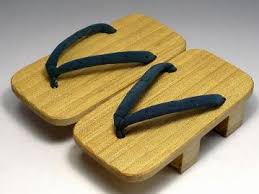 Geta (usually yukata)
Geta (usually yukata)Geta are platform sandals that keep your kimono from dragging on the ground. They also keep your feet high and dry above the snow and rain. There are 3 major version of the geta with many variations based on these simple design, a balancing act with a single tooth, also called a tengu-geta, a more comfortable 2 tooth version (see image) and an easy to walk on modern version with no visible tooth.
Geta aren't particularly formal. They're commonly worn with yukata with bare feet, tough you will notice when a shrine maiden walks on a geta she wears tabi socks. You'll see many people in geta at summer matsuri and fireworks. Paulownia wood is popular for geta.
 Setta (usually kimono)
Setta (usually kimono)Walking on a is usually combined with socks/Tabi but not necessarily. Having put on an haori, socks are needed, be it geta or setta.
A setta is made of bamboo peel (竹の皮) or palm leaves (棕櫚の葉) woven into tatami.
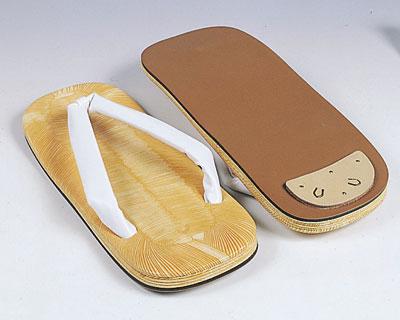 Zōri (usually kimono)
Zōri (usually kimono)Zori are made of of leather, vinyl or fabric nowadays; used to be made of straw in the past as represented by the 'grass' kanji (草, zou) in the Japanese name.
There are those with tatami surface and cork core.
The presence of cork core indicate it is a zouri, not a setta, regardless of the core's thickness, tatami surface and gender.
Hanao (thongs) is attached evenly to the sandal, so there is no difference between the left and right setta. By swapping the left for the right, you may avoid the wearing down of one particular side of the sole. For this reason, you are supposed to wear them with you fifth toe hanging slightly out of the edge of the sandal.
International Shoe size comparison chart
Some variations of the geta / Japanese Style Raised Wooden Sandals
 Standard Hiyori geta / Masa geta
Standard Hiyori geta / Masa geta  Standard geta
Standard geta Round geta
Round geta  1 tooth geta
1 tooth geta The way to wear geta is to allow your heel to slightly (1 to 3cm) stick out over the geta heel. A size smaller than your actual foot size is recommended, bigger size should be avoided especially for those who are not used to wearing geta. This type of footwear is worn only by a thong between the big toe and the second toe, if the sole is longer than your feet, your toes would have the burden of that weight and you probably will drag the end of the sole on the ground.

Walking on setta



Until you are used to wearing setta, you may feel discomfort or even pain in your heel. If you feel pain, move your heels in and out of the setta so that the angle that your skin is rubbing against the hanao changes. If you skin becomes raw,use a band-aid.
Your toe skin can also be sensitive to the rubbing on the hanao at first, once your skin is used to it ,it will not longer hurt.
Major cause of discomfort with new setta is usually that the hanao may not be softened enough yet. The hanao material will gradually be come more soft and fit to your feet, unless your hanao is made of a Particularly stiff material.
One more reason can be that your setta may not be suitable to your feet. If the hanao is extremely tight or loose, it may not only hurt your skin at the point where your skin rubs on the hanao but may also make you feel tired and affect your health.
For those pilgrimage walks the waraji can be choosen. Not sure what the formality level is, but I guess it is casual as the geta footwear ?
 Comfortable ?
Comfortable ?How to walk
- Walk dragging your heel (this is the basic style) but be careful not to flipflop the setta, which is considered sloppy. I found it harder than expected to not flipflop.
- Straighten your back and shuffle your feet rhythmically and elegantly, if you drag your heel well enough the heel metal will make a fine clicking sound and that is considered stylish.
The original English page where this info came from can be found at Zheng Fai Limited
An how to walk course from Mr. Maeda in Japanese. (Have not been able to find an english instruction video yet)


Bag
You will see lot of sites which advertise a kinchaku bag (巾着) when you want to carry your belongings, but did you know there are other fashionable options that you could use ?
 kinchaku bag
kinchaku bag巾着
 obi hanging pouch with netsuke
obi hanging pouch with netsuke帯掛けポーチ (根付)
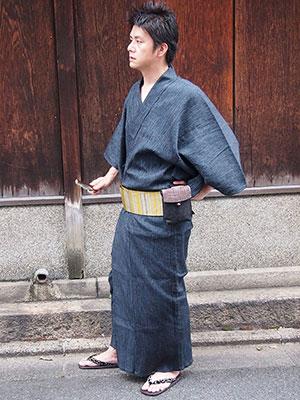 waist pouch
waist pouchウエストポーチ
 shoulder bag
shoulder bagショルダーバッグ
If you want more foto's/ideas of men in kimono wearing bags I recommend Otoko Kimono no kato where above images came from.
* obi hanging pouch with netsuke: The cord between the bag and the netsuke goes behind the obi.


Scarf
For the cold days, don't forget the scarf!




Was suprised, but yes, a scarf seems an acceptable clothing accessory (nowadays ?).
Go back to page 1 on "How to wear a kimono"
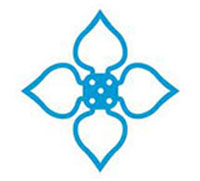


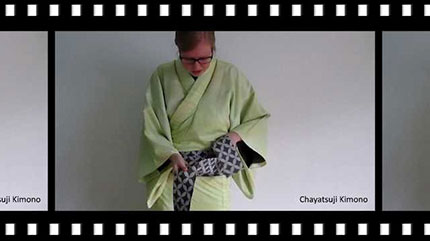
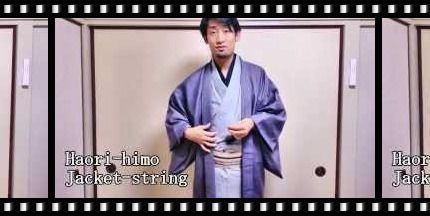
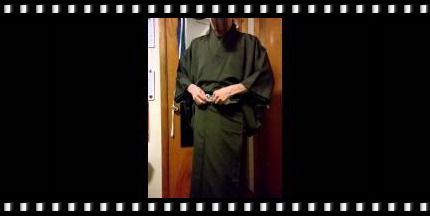
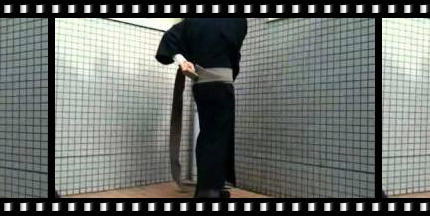
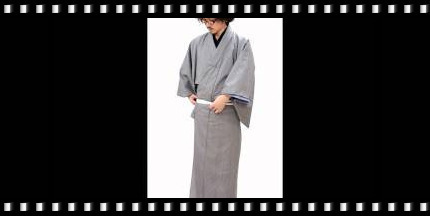
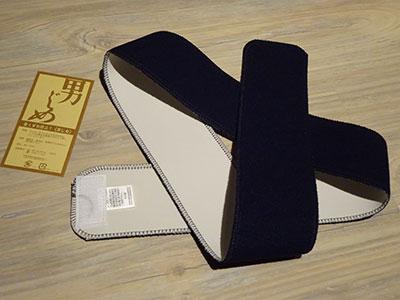 Date Jime
Date Jime
